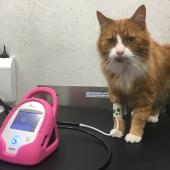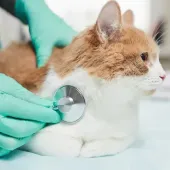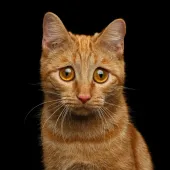The Causes of Heart Disease in Cats: A Comprehensive Guide

Heart disease in your cat
Heart disease is increasingly common in cats probably because their average life expectancy has increased due to improved veterinary care. Some heart defects may be present from birth but only show symptoms as the cat gets older. Other diseases develop later in life as a result of the effects of ageing or damage to the heart. The most common heart disease which develops later in life is hypertrophic cardiomyopathy.

How does the heart work?
The cat's heart, like that of humans, is a muscular pump with four separate chambers. The right side of the heart sends blood to the lungs where it picks up oxygen. The left side receives blood from the lungs and pumps it around the rest of the body. The chambers are separated from one another by a series of valves that ensure that blood can only flow in the right direction around the heart.
The causes
Heart disease is a serious concern for feline companions, and understanding its causes is vital for both prevention and effective management. While the exact origins of heart disease in cats can be complex and multifaceted, there are several common factors and conditions that contribute to the development of heart-related issues in our feline friends.
1. Genetics: Genetic predisposition plays a significant role in many heart diseases in cats. Certain breeds, such as Maine Coons, Ragdolls, and Persians, are more prone to specific cardiac conditions like Hypertrophic Cardiomyopathy (HCM). Genetic mutations can lead to structural abnormalities in the heart, making it less efficient in pumping blood.
2. Hypertension (High Blood Pressure): Just like in humans, hypertension can damage the heart over time. Cats with high blood pressure are at a higher risk of developing heart disease. Kidney disease, hyperthyroidism, and diabetes are common underlying causes of hypertension in cats.
3. Thyroid Disorders: Both hyperthyroidism (overactive thyroid) and hypothyroidism (underactive thyroid) can impact the heart. Hyperthyroidism can lead to increased heart rate and blood pressure, putting strain on the heart, while hypothyroidism can cause a decrease in heart rate and cardiac output.
4. Valve Abnormalities: Malfunctioning heart valves can cause irregular blood flow, leading to strain on the heart muscle. Conditions like Mitral Valve Disease (MVD) can cause backflow of blood, further weakening the heart over time.
5. Cardiomyopathies: Cardiomyopathies are diseases that affect the heart muscle itself. Hypertrophic Cardiomyopathy (HCM), where the heart muscles thicken, is the most common cardiomyopathy in cats. Dilated Cardiomyopathy (DCM), which causes the heart chambers to enlarge, is also a concern.
6. Infections: Infections such as bacterial endocarditis, a bacterial infection of the heart valves and/or inner lining of the heart, can cause heart disease. These infections can damage the heart valves, leading to complications.
7. Age and Lifestyle: Older cats are more susceptible to heart disease, highlighting the importance of regular veterinary check-ups as cats age. Additionally, an unhealthy lifestyle, including obesity and lack of exercise, can contribute to the development of heart-related problems.
8. Toxins and Medications: Certain toxins, such as lilies, and some medications can lead to heart issues in cats. It's essential for cat owners to keep potentially harmful substances out of their pet's reach and to administer medications under veterinary supervision.
Areas affected
Heart disease may affect any area of the heart:
Heart valves
The valves within the heart may fail to develop properly, eg mitral dysplasia, or may degenerate as a result of ageing (endocardiosis). Specific infections can affect the heart valves (endocarditis). Abnormal valves allow leakage of blood between heart chambers even when they are closed. When valves leak abnormal blood flow can be detected when listening to the heart (a murmur) and on ultrasound.
Heart Muscle
In general terms the heart muscle may be either too thick or too thin. If the muscle is too thin the heart is unable to contract properly and if the muscle is thick the heart cannot relax and therefore does not fill with blood between contractions. In either case the heart is unable to pump sufficient blood out.
Electrical conduction
Abnormal electrical conduction affects the rate and rhythm of the heart. Electrical abnormalities can be caused by disease outside the heart. If the heart beats too quickly there is not enough time for it to fill properly between beats and so it pumps less blood with each beat. If the heart beats too slowly there are not enough pulses to supply enough blood to the body. Chaotic rhythms occur where contractions of different parts of the heart are not synchronised and so pulse volume is reduced.
Pericardium
The pericardium is a strong sac that surrounds and supports the heart. Changes to the pericardium usually result in constriction of the heart, preventing it from filling properly between contractions. The right side of the heart (because it has thinner walls) is usually more easily compressed than the left. diseases of the pericardium are very rare in cats.
Kittens can be born with heart defects (congenital heart problems) because the heart does not develop normally. The most common problems are leaky valves and holes inside the heart that allow blood to flow in abnormal directions. Heart disease in older cats is usually caused by changes in the heart muscle.
In conclusion, understanding the various causes of heart disease in cats is crucial for early detection and prevention. Regular veterinary visits, especially for senior cats, a balanced diet, a stress-free environment, and an active lifestyle can significantly reduce the risk of heart-related issues. By staying informed and proactive, cat owners can provide the best possible care for their feline companions, ensuring they live long, healthy, and happy lives.





